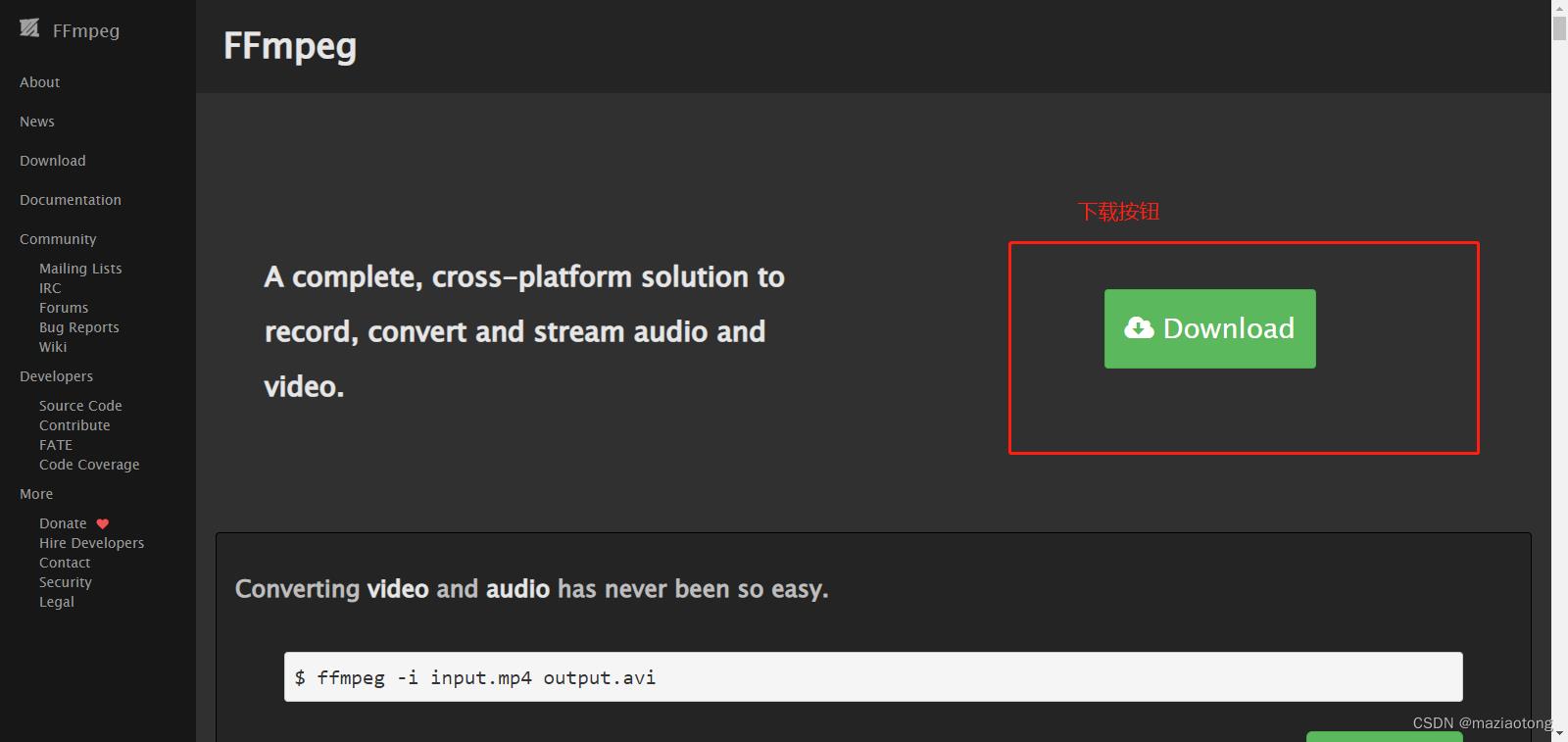java实现音视频的合并
Posted maziaotong
tags:
篇首语:本文由小常识网(cha138.com)小编为大家整理,主要介绍了java实现音视频的合并相关的知识,希望对你有一定的参考价值。
前端时间从某B站下载了一些视频到本地,但是音频和视频是分开存放的,视频名称也是存放在json文件中,因为视频比较多,因此呢就写了个demo来处理一下,下面是代码
首先,第一部分是修改文件名称,从网站下载的视频和音频是分开的,文件名称隐藏在entry.json文件中的part字段中
/**
* 文件路径
*/
private static File file = new File("F:\\\\视频\\\\尚硅谷nginx");
/**
* 修改文件名
*/
public static void getFile()
File[] files = file.listFiles();
//循环取出路径下的所有文件
for (File file1 : files)
//获取文件名称
String name = getJSON(file1);
//修改音视频所在文件夹名称
file1.renameTo(new File(file.getPath() + File.separator + name));
/**
* 获取文件名称
* @param file1
* @return
*/
public static String getJSON(File file1)
//文件名称隐藏在entry.json文件中的part字段中
File file2 = new File(file1.getPath() + File.separator + "entry.json");
char[] chars = new char[(int) file2.length() * 2];
try
//读取entry.json文件内容
FileReader fr = new FileReader(file2);
fr.read(chars);
String str = new String(chars);
fr.close();
JSONObject ret = JSON.parseObject(str);
ret = JSON.parseObject(ret.getString("page_data"));
//返回文件名称
return ret.getString("part");
catch (FileNotFoundException e)
e.printStackTrace();
catch (IOException e)
e.printStackTrace();
return "";
第二部分是删除多余文件,包括视频信息文件和弹幕文件
/**
* 删除多余文件
*/
public static void deleteDanmaku()
File[] files = file.listFiles();
for (File file1 : files)
File danmaku = new File(file1.getPath() + File.separator + "danmaku.xml");
//entry.json中是视频信息
File entry = new File(file1.getPath() + File.separator + "entry.json");
//index.json文件中是弹幕
File index = new File(file1.getPath() + File.separator + "80" + File.separator + "index.json");
danmaku.delete();
entry.delete();
index.delete();
第三部分修改音频和视频的后缀,原后缀是m4s
/**
* 修改音视频名称和后缀
*/
public static void updateRedi()
File[] files = file.listFiles();
for (File file1 : files)
//修改视频名称和后缀
File videoFile = new File(file1.getPath() + File.separator + "80" + File.separator + "video.m4s");
boolean videoBoo = videoFile.renameTo(new File(file1.getPath() + File.separator + "80" + File.separator +
file1.getName() + ".mp4"));
//修改音频名称和后缀
File audioFile = new File(file1.getPath() + File.separator + "80" + File.separator + "audio.m4s");
boolean audioBoo = audioFile.renameTo(new File(file1.getPath() + File.separator + "80" + File.separator +
file1.getName() + ".mp3"));
System.out.println(videoBoo == audioBoo ? true : false);
第四部分是移动文件,将音视频文件从80文件夹中取出
第五部分是合并视频和音频,使用ffmpeg
先本地安装ffmpeg,官网地址:FFmpeg
进入后点击下载按钮

我的是windows系统,选择windows后,点击第一个

进入后点击ffmpeg-git-full.7z版下载压缩包

解压后可以看到这样的目录

这样我们就下载完毕,可以配置环境变量了,在文件管理器中,鼠标右键此电脑属性,进入高级系统设置,点击环境变量,在系统变量中的path中,将ffmpeg\\bin目录的路径放进去即可
然后可以打开cmd窗口,键入ffmpeg -version命令,如果弹出ffmpeg的版本即为安装成功
ok,安装完毕,我们可以合并音视频了
ffmpeg命令格式
ffmpeg -i 原视频路径 -i 原音频路径 -codec copy 合并后视频存放路径+视频名称Runtime.getRuntime().exec()用于调用系统外部的某个程序,他会生成一个新的进程去运行调用的程序。此方法返回一个java.lang.Process对象,该对象可以得到之前开启的进程的运行结果,还可以操作进程的输入输出流。
process.waitFor()获取进程运行结束后的返回状态,如果进程未运行完毕则等待直到执行完毕
但是waitFor()方法有很明显的弊端,因为java程序给进程的输出流分配的缓冲区是很小的,有时候当进程输出信息很大的时候回导致缓冲区被填满,如果不及时处理程序会阻塞。如果程序没有对进程的输出流处理的会就会导致执行exec()的线程永远阻塞,进程也不会执行下去直到输出流被处理或者java程序结束。
这就是为什么process.waitFor()执行后程序一直无法结束的原因
解决的方法就是处理缓冲区中的信息,开两个线程分别去处理标准输出流和错误输出流。
因此呢我又写了一个工具类来处理输出流execStream类
/**
* 合并音视频
*/
public static void ffmpegMerge()
File[] files = file.listFiles();
for (File file1 : files)
//取出音频和视频文件
File[] files2 = file1.listFiles();
//拼接ffmpeg命令
String command = "D:\\\\toos\\\\ffmpeg\\\\bin\\\\ffmpeg.exe" + " -i " + files2[1].getPath() + " -i " + files2[0].getPath() + " -codec copy " +
file.getPath() + File.separator + files2[1].getName();
Process process = null;
try
//执行本地命令
process = Runtime.getRuntime().exec(command);
//因为process的输出流缓冲区很小,会导致程序阻塞,因此自己写个工具类对进程的输出流进行处理
execStream stream = new execStream(process.getErrorStream(), "ERROR");
stream.start();
execStream stream1 = new execStream(process.getInputStream(), "STDOUT");
stream1.start();
//得到进程运行结束后的返回状态,如果进程未运行完毕则等待知道执行完毕,正确结束返回int型的0
process.waitFor();
catch (IOException | InterruptedException e)
e.printStackTrace();
输出流处理工具类,在关闭时pw.close()可能会报错,但不影响最终结果
import java.io.*;
public class execStream extends Thread
private InputStream is;
private String type;
private OutputStream os;
public execStream(InputStream is, String type)
this.is = is;
this.type = type;
public execStream(InputStream is, String type, OutputStream os)
this.is = is;
this.type = type;
this.os = os;
@Override
public void run()
InputStreamReader isr = null;
BufferedReader br = null;
PrintWriter pw = null;
try
if (os != null)
pw = new PrintWriter(os);
isr = new InputStreamReader(is);
br = new BufferedReader(isr);
String line = null;
while ((line = br.readLine()) != null)
if (pw != null)
pw.println(line);
if (pw != null)
pw.flush();
catch (IOException e)
e.printStackTrace();
finally
try
pw.close();
br.close();
isr.close();
catch (IOException e)
e.printStackTrace();
好了,以上就是所有的内容。
如何使用 java 合并 .webm(音频)文件和 .mp4(视频)文件?
【中文标题】如何使用 java 合并 .webm(音频)文件和 .mp4(视频)文件?【英文标题】:How can I merge .webm (Audio) file and a .mp4 (Video) file using java? 【发布时间】:2016-06-26 15:12:56 【问题描述】:我有两个文件,一个是 .webm 音频文件,另一个是 .mp4 视频文件 有没有办法使用 java 将这两个文件组合在一起?
提前致谢。
【问题讨论】:
【参考方案1】:这可以通过JNI 使用ffmpeg C 库或通过执行ffmpeg 命令行二进制文件来实现。
下面是命令行执行的步骤:
下载 FFmpeg:http://ffmpeg.org/download.html .您可以从repository 下载源代码并根据您的机器架构构建它们。
将下载的文件解压到特定文件夹,例如 c:\ffmpeffolder 使用 cmd 移动到特定文件夹 c:\ffmpeffolder\bin
运行以下命令:$ ffmpeg -i audioInput.webm -i videoInput.mp4 -acodec copy -vcodec copy outputFile.avi
Java 命令行执行:https://***.com/a/8496537/2900034
就是这样。 outputFile.avi 将是结果文件。
或者如果你想解决 ffmpeg C 库
这里有一些好的开始。
-
JNI。
ffmpeg api example。
【讨论】:
以上是关于java实现音视频的合并的主要内容,如果未能解决你的问题,请参考以下文章